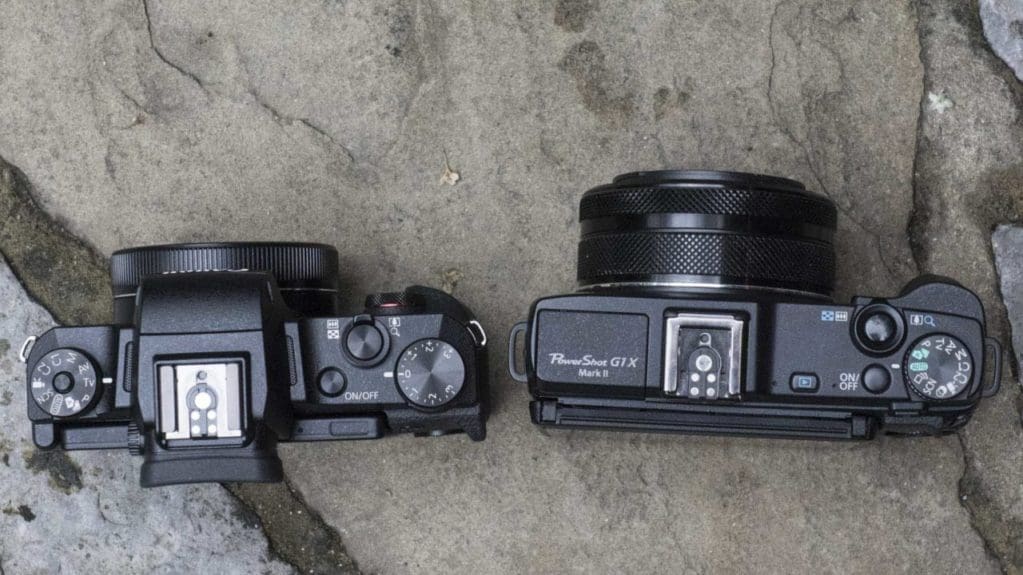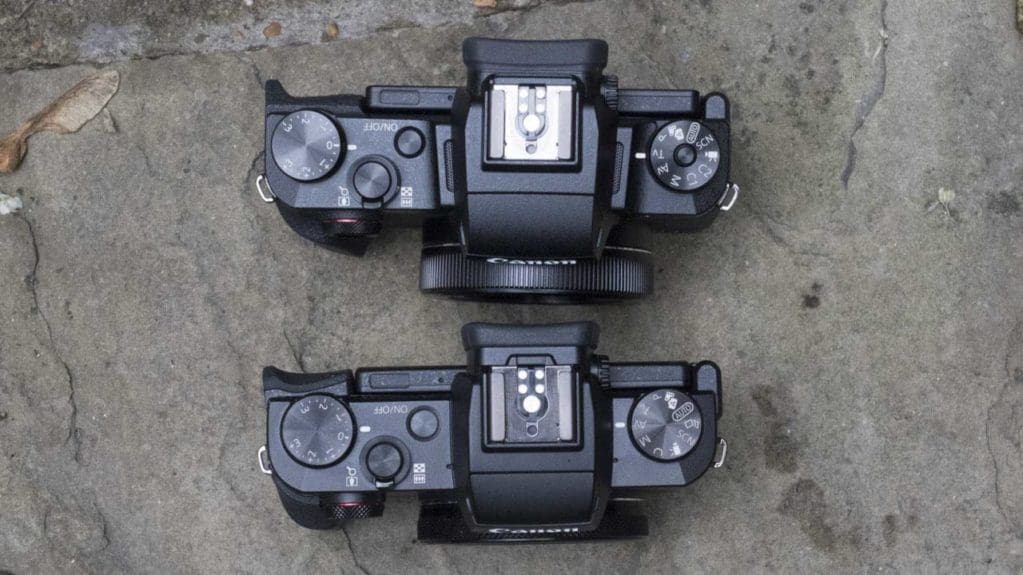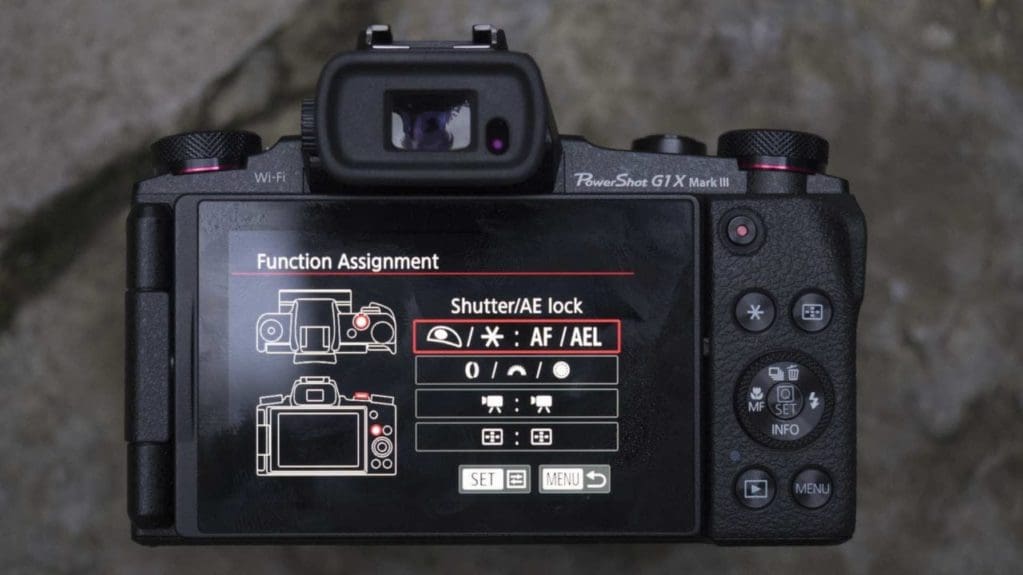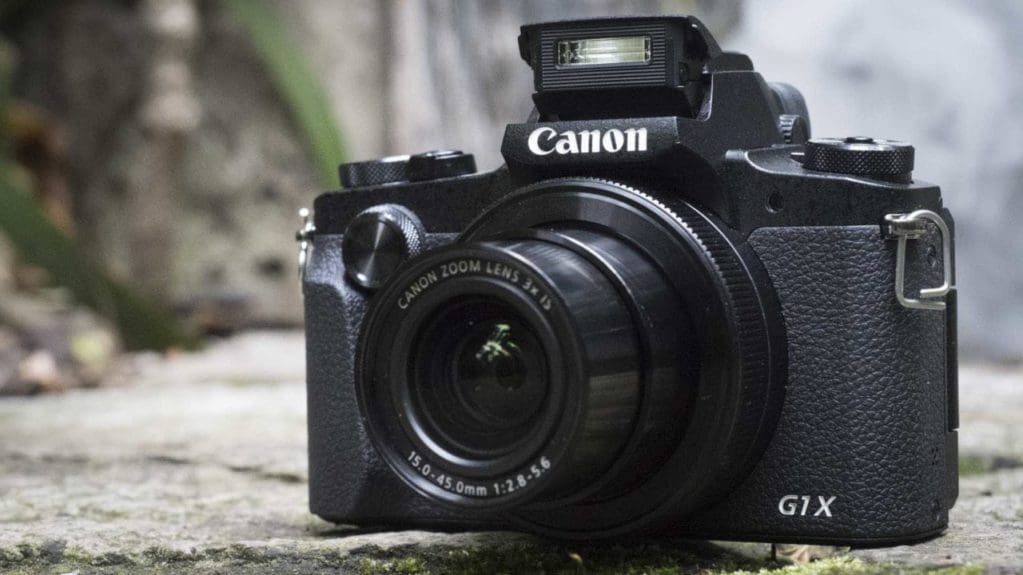What is the Canon PowerShot G1 X Mark III?
The Canon PowerShot G1 X Mark III is a compact camera and the replacement to the PowerShot G1 X Mark II. However, whereas its predecessor has a 1.5 type (18.7 mm x 14.0 mm) sensor, the Mark III has an APS-C format device which measures 22.3 x 14.9mm, the same as in Canon DSLRs like the Canon 80D. Even better news is that Canon has also managed to make the PowerShot G1 X Mark III 16% smaller than the Mark II and included both a viewfinder and a zoom lens.
Canon PowerShot G1 X Mark III Features
Canon has given the G1 X III a 24.2Mp sensor which is thought to be the same or certainly very similar to the one in the Canon 80D. This is coupled with a DIGIC 7 processor which enables a sensitivity (ISO) range of 100 – 25,600.
For the first time in a compact camera, Canon has given the G1 X Mark III Dual Pixel CMOS AF (autofocus). That means that there’s phase detection focusing in Live View and video mode, just as you get with Canon’s recent DSLRs and mirrorless cameras like the EOS M6. In the G1 X Mark III it’s claimed to achieve focus in 0.09 seconds. There’s also a 4-stop Image Stabilisation (IS) system which should help with producing sharp images in low light when shutter speeds fall.
Canon is still convinced that nobody wants or needs 4K video so the maximum video resolution available is Full-HD (1920×1080) at 59.94, 50, 29.97, 25 or 23.98fps (frames per second). There’s also 5-axis Advanced Dynamic IS in video mode.
As in other recent Canon cameras, the G1 X Mark III has Wi-Fi, Dynamic NFC and Bluetooth connectivity built-in for easy pairing and image sharing with a smartphone. It’s even possible to waken the camera and transfer images to a phone when it’s out of reach, perhaps when it’s your bag after a shoot.
Canon PowerShot G1 X Mark III Lens
As it’s a compact camera, the G1 X III has a fixed (ie not interchangeable) lens. Canon has plumped for a 15–45mm f/2.8-5.6 optic which produces the 35 mm equivalent of 24–72 mm. That’s a drop from the 24–120mm equivalent lens of the G1 X II, but it’s a knock-on effect of using a larger sensor while reducing the size of the camera, so we’ll take it – and it’s still a good focal length range for everyday photography.
The reduction in maximum aperture size from f/2.0-3.9 with the G1 X Mark II to f/2.8-5.6, however, is a bit more restricting, especially in low light. But the lens should be nicely matched with the sensor to optimise image quality and the 9-blade aperture should help make attractive bokeh (out of focus areas).
Canon PowerShot G1 X Mark III Build and Handling
The first thing that strikes you about the PowerShot G1 X Mark III is how small it is for a camera with an APS-C format sensor and a zoom lens. It’s noticeably smaller and lighter than the G1 X Mark II that it replaces.

It’s actually very close in size to the PowerShot G5 X which has a 1-inch type sensor.

Thanks to a pronounced front grip and rear thumb rest, both of which have a rubber-like coating, the G1 X III feels safe in your grasp and it’s comfortable to use one-handed.
There are also weather-seals to keep out moisture and dust. And if you want to take the PowerShot G1 X Mark III underwater, there’s an optional housing that will keep it safe down to 40m (130 feet).
Canon anticipates that many G1 X Mark III owners will also use a DSLR and so it has designed the controls to appeal to these advanced users. There’s a Control Ring around the lens, for example, that can be used to adjust a range of features, I found it useful for zooming the lens or adjusting aperture. Meanwhile, there’s a mode dial on the top-plate to select the exposure mode and an exposure compensation dial for making speedy adjustments.
The menu will seem familiar to Canon DSLR users and there’s a helpful screen to facilitated customising some of the controls.

Canon PowerShot G1 X Mark III Viewfinder and Screen
At the centre of the G1 X III’s top-plate is a 0.39-inch type OLED electronic viewfinder with 2.36 million dots. It’s not the largest viewfinder around, but it’s not the smallest either and it provides a good view with plenty of detail. It feels like a nice bonus on a compact camera.
Images can also be composed on the 3-inch 1,040,000 vari-angle touchscreen. The vari-angle aspect is especially useful when you’re composing shots above or below headlight and it’s helpful for both landscape or portrait format images.
The inclusion of Touch and Drag Auto Focus (AF) means that can set the focus point with your thumb on the screen even if you’re looking through the viewfinder. You can designate an area of the screen to use for setting the AF point – that’s useful if you find your nose does the job for you when the whole screen is active. It’s a very intuitive way of shooting when you’re looking in the viewfinder and I found the screen very responsive.

Canon PowerShot G1 X Mark III Performance
The Canon PowerShot G1 X Mark III appears to be very capable, delivering attractive, detailed-looking images. The autofocus system performed well, even with small, low contrast subjects in low light conditions. The camera’s Evaluative metering mode generally produced nicely exposed images, with exposure compensation needed only for very dark subjects. The image stabilization system also seems effective, with sharp images achievable at slow shutter speeds like 1/13 sec and even 1/6 sec at the longest point of the lens.
Canon PowerShot G1 X Mark III Image Quality
Images taken at ISO 100 show a good level of natural-looking detail. While noise control is effective up to around ISO 3200, maintaining a good detail level, some detail loss and a slight granular texture are evident at ISO 6400, though the results are still acceptable for high sensitivity settings. The color reproduction is consistent with Canon DSLRs, with the Standard Picture Style and Auto white balance settings producing warm, realistic colors, particularly in artificially lit environments.
Canon PowerShot G1 X Mark III Sample Images













Canon PowerShot G1 X Mark III Early Verdict
Canon’s PowerShot G-series has been popular among enthusiast photographers, and the PowerShot G1 X Mark III seems poised to continue this trend. Despite the impact of smartphones on compact camera sales, there appears to be a market for high-quality compact cameras, as shown by Fuji’s success with its APS-C format models like the X100F and X70. The G1 X Mark III, being smaller than the X100F and featuring a vari-angle touchscreen and a zoom lens, adds to its appeal compared to Fuji’s prime lens offerings.
The size of the G1 X III is surprising, especially considering it houses an APS-C sized sensor and a zoom lens. The combination of a sensor similar to that in the Canon 80D, the Digic 7 processor, and a lens offering a 24-72mm equivalent focal length range seems promising. The initial results from the Beta sample camera are encouraging.
Should I buy the Canon PowerShot G1 X Mark III?
While it’s early to make a definitive recommendation, the Canon PowerShot G1 X Mark III is a compelling option for those seeking a compact camera with DSLR-like image quality without the need for interchangeable lenses. Its versatility and performance make it a strong contender, potentially offering more flexibility than the Fuji X100F.



